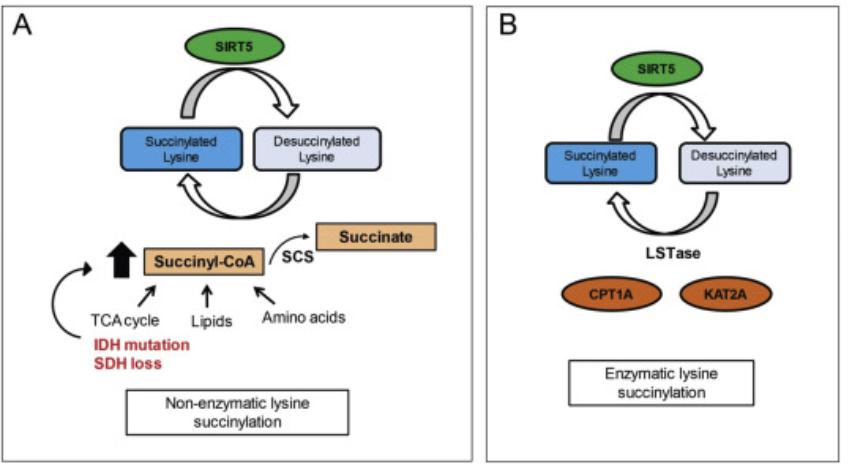Lysine succinylation modification is a novel post-translational modification (PTM) of histones that are commonly
found in the cytoplasm and nucleus of all prokaryotes and eukaryotes, participates in and regulates biological
processes in almost all organisms, and is closely associated with diseases. Creative Proteomics
specializes in the analysis and identification of PTMs based on high-resolution mass spectrometry (MS), aiming to
provide quality and efficient solutions for our customers' research projects. Here, we offer protein
succinylation analysis services, including protein extraction and proteolysis, peptide enrichment and separation,
liquid chromatography-tandem mass spectrometry (LC-MS/MS) analysis, MS raw data analysis, and bioinformatics
analysis.
Protein succinylation
Lysine succinylation, defined as the transfer of a succinyl group to a lysine residue of a protein, is dynamic,
reversible, and evolutionarily conserved and has been extensively studied in both mammalian and bacterial cells.
MS-based proteomic analysis identified a large number of lysine succinylated-cytosolic, mitochondrial and nuclear
proteins, taking part in various cellular and biological processes, such as fatty acid oxidation, metabolic enzymes
for fatty acid synthesis, amino acid degradation, and mitochondrial respiration. In addition, emerging clinical
studies have reported that dysregulation of protein succinylation is associated with cardiovascular diseases,
cancer, and other diseases. Therefore, an in-depth understanding of succinylation modification and its regulatory
mechanisms is important for understanding its physiological functions as well as for developing drug therapies.
 Fig. 1
Metabolic regulation of Ksucc by succinyl-CoA (A). Enzymatic regulation of Ksucc (B). (Sreedhar, et al.,
2020)
Fig. 1
Metabolic regulation of Ksucc by succinyl-CoA (A). Enzymatic regulation of Ksucc (B). (Sreedhar, et al.,
2020)
Proteomics analysis of succinylation
With advanced experimental techniques, Creative Proteomics is dedicated to offering fast and
accurately succinylated proteins and lysine succinylation sites. We are able to characterize lysine succinylation,
the distribution of modification sites, and the main influencing factors. Specifically, our service includes the
following lists:
- Protein extraction and trypsin digestion.
- HPLC fractionation.
- Affinity enrichment of lysine succinylated peptides.
- LC-MS/MS analysis.
- Database searching and analysis.
- Bioinformatics analysis.
-Protein annotation.
-KEGG pathway annotation.
-GO/KEGG pathway functional enrichment analysis.
-Analysis of sequence model around succinylation sites.
-Motif-based clustering analysis.
Service features
- Mainstream antibody affinity enrichment method with high specificity and good enrichment efficiency.
- Large-scale identification of the enriched succinylated peptides by powerful MS analysis.
- Allow quantitative comparison of the differences in succinylation levels between different samples.
- A research team with extensive experience in PTMs.
- Provide a variety of bioinformatics analyses.
- One-stop service.
Workflow of protein succinylation analysis

Sample requirements
- Acceptable samples: Protein extracts, cell samples, tissue samples, and microorganism samples.
- Sample shipping: Sufficient amount of dry ice for shipping, or consult our technical staff before sending
samples.
- Before the formal experiment, we will always test the samples you provide.
Applications of our service
- Investigate the role of lysine succinylation in cellular physiology.
- Explore the role of lysine succinylation in pathology, such as cancers, heart disease, and neurological
diseases.
- Identify lysine succinylation in numerous microorganisms, including bacteria, pathogenic bacteria, and fungi.
- Identify lysine succinylation in mammalian cells (human and mouse), protozoan, and parasites.
- Identify lysine succinylation in plants.
As a newly discovered PTM, succinylation not only triggers more changes in protein properties but also has more
significant effects on protein structure and function because of the larger spatial structure of the succinyl group.
If you are interested in our protein succinylation analysis, please feel free to contact us. We are ready to assist you!
References
- Sreedhar, Annapoorna, Elizabeth K. Wiese, and Taro Hitosugi. "Enzymatic and metabolic regulation of lysine
succinylation." Genes & Diseases 7.2 (2020): 166-171.
- Yang, Yun, and Gary E. Gibson. "Succinylation links metabolism to protein functions."
Neurochemical research 44.10 (2019): 2346-2359.
Our products and services are for research use only.


 Fig. 1
Metabolic regulation of Ksucc by succinyl-CoA (A). Enzymatic regulation of Ksucc (B). (Sreedhar, et al.,
2020)
Fig. 1
Metabolic regulation of Ksucc by succinyl-CoA (A). Enzymatic regulation of Ksucc (B). (Sreedhar, et al.,
2020)

